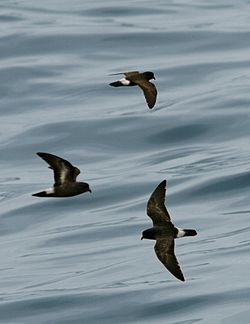Northern storm petrel
| Northern storm petrels | |
|---|---|
 |
|
| European storm petrels | |
| Scientific classification | |
| Kingdom: | Animalia |
| Phylum: | Chordata |
| Class: | Aves |
| Order: | Procellariiformes |
| Family: |
Hydrobatidae Mathews, 1912 |
| Genera | |
Northern storm petrels are seabirds in the family Hydrobatidae, part of the order Procellariiformes. The family was once lumped with the similar austral storm petrels in the combined storm petrels, but have been split as they were not closely related. These smallest of seabirds feed on planktonic crustaceans and small fish picked from the surface, typically while hovering. Their flight is fluttering and sometimes bat-like.
The northern storm petrels are found in the northern hemisphere although some species around the equator dip into the south. They are strictly pelagic, coming to land only when breeding. In the case of most species, little is known of their behaviour and distribution at sea, where they can be hard to find and harder to identify. They are colonial nesters, displaying strong philopatry to their natal colonies and nesting sites. Most species nest in crevices or burrows and all but one species attend the breeding colonies nocturnally. Pairs form long-term monogamous bonds and share incubation and chick-feeding duties. Like many species of seabird, nesting is highly protracted with incubation taking up to 50 days and fledging another 70 days after that.
Several species of storm petrel are threatened by human activities. One species, the Guadalupe storm petrel, is thought to have gone extinct. The principal threats to storm petrels are introduced species, particularly mammals, in their breeding colonies; many storm petrels habitually nest on isolated mammal-free islands and are unable to cope with predators like rats and feral cats.
...
Wikipedia
